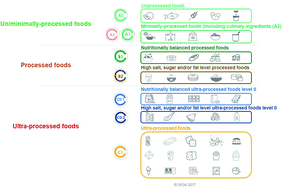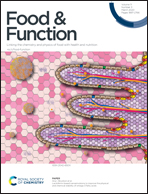The holistico-reductionist Siga classification according to the degree of food processing: an evaluation of ultra-processed foods in French supermarkets
Abstract
The qualitative NOVA classification of foods according to their degree of processing is used worldwide by researchers. NOVA defines ultra-processed foods (UPFs) by the presence of processed industrial ingredients and additives to modify the sensory properties (aroma, taste, colour and texture) of reconstituted food, named ‘cosmetic’ compounds, i.e., modifying food appearance. Some drastic processes directly applied to food are also markers of ultra-processing. However, with the intent to develop an elaborate tool for industries and retailers, the Siga classification was developed by combining the four holistic NOVA groups with four more new reductionist subgroups considering the impact of processing on the food/ingredient matrix; the contents of added salt, sugar and fat; the nature and number of markers of ultra-processing (MUPs); and the levels of at-risk additives (groups are unprocessed, A0; minimally processed foods, A1; culinary ingredients, A2; balanced foods, B1/C0.1; high salt, sugar and/or fat level foods, B2/C0.2; processed/ultra-processed foods; and UPFs with more than one MUP, C1). The Siga algorithm was used to characterize 24 932 packaged foods in French supermarkets (baby foods and alcohol excluded), which were representative of the packaged food assortments. The main results showed that two-thirds of the products were ultra-processed. Products with more than one MUP (C1) corresponded to the most represented category, accounting for 54% of the products. Among foods with more than five ingredients, 75% were UPFs. Considering all products, the average number of ingredients, MUPs and at-risk additives were 10.1, 2.6 and 0.5, respectively. Among food categories, some contained a high percentage of UPFs: 94, 95, 95, 81, 80, and 87% for salted meats, cooked dishes, flavoured yogurts/white cheeses, energy and gourmet bars, breakfast cereals, and vegetarian dishes, respectively. Finally, the Siga algorithm presents a useful tool for improving the health potential of packaged food and for decision-making on search engine optimization (SEO) policy and assortment management in supermarkets.

- This article is part of the themed collection: Food & Function Recent HOT articles


 Please wait while we load your content...
Please wait while we load your content...